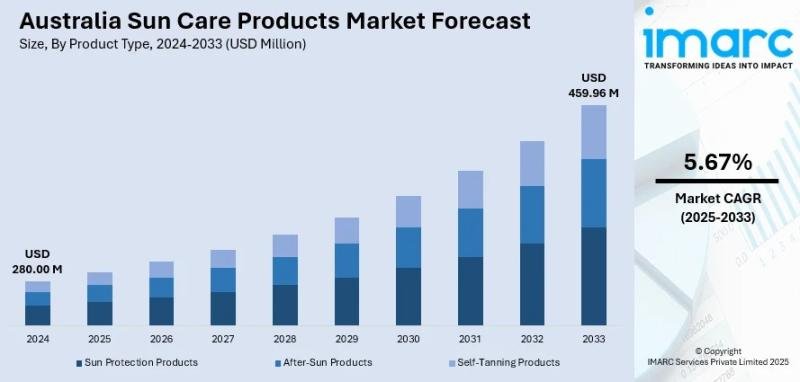Australia Sun Care Products Market: A Comprehensive Overview
The Australian sun care products market is currently experiencing significant growth, with expectations to reach USD 459.96 million by 2033. This trajectory is fueled by rising awareness of health risks associated with UV radiation, innovative products, and shifting consumer preferences.
Market Size and Projections
- Current Market Size (2024): USD 280.00 million
- Forecasted Market Size (2033): USD 459.96 million
- Compound Annual Growth Rate (CAGR): 5.67% (2025-2033)
Historical Context
The report considers data from the years 2019 to 2024, providing a comprehensive understanding of market evolution and trends.
Drivers of Market Growth
Australians are increasingly vigilant regarding sun protection due to the country’s high incidence of skin cancer. Government campaigns, including the iconic “Slip-Slop-Slap,” have significantly influenced consumer behavior, promoting regular sunscreen usage.
Key Drivers Include:
- Public Awareness: Increased knowledge of UV-related health risks.
- Health Initiatives: Government and NGO advocacy for protective measures.
- Product Innovation: New formulations catering to various preferences, including lightweight and mineral-based options.
Market Segmentation
The sun care products market is diverse, with several categories designed to meet the unique needs of consumers.
By Product Type:
- Sun Protection Products
- After-Sun Products
- Self-Tanning Products
By Product Form:
- Cream
- Gel
- Lotion
- Wipes
- Spray
By Gender:
- Female
- Male
- Unisex
By Distribution Channel:
- Supermarkets and Hypermarkets
- Specialty Retailers
- Pharmacies
- Online Stores
By Region:
- Australia Capital Territory & New South Wales
- Victoria & Tasmania
- Queensland
- Northern Territory & South Australia
- Western Australia
Trends Influencing the Market
Several trends are shaping the landscape of Australia’s sun care products market:
Notable Trends:
- UV Awareness: Increasing public awareness surrounding the dangers of UV exposure.
- Demand for Mineral-Based Products: A shift towards products that are gentle on sensitive skin and contain mineral ingredients.
- Innovative Formats: Growing popularity of sprays, mists, and sticks that offer convenience and ease of application.
- Environmental Sustainability: Rising consumer preference for reef-safe and eco-friendly formulations.
Challenges and Opportunities
Challenges:
- Regulatory Compliance: Adhering to stringent safety standards for product efficacy.
- Consumer Education: Ensuring proper usage and understanding of sun protection methods.
- Intense Competition: Facing numerous domestic and international brands with varied offerings.
Opportunities:
- Advanced Product Development: Innovations integrating skincare benefits with sun protection.
- Eco-Conscious Market: Expanding demand for biodegradable and reef-safe formulations.
- E-commerce Growth: Leveraging online platforms to widen market reach and accessibility.
The Importance of Sustainability
With a growing focus on environmental issues, many brands are adapting to consumer demands for sustainable practices. This includes:
- Biodegradable Packaging: Reducing plastic waste through sustainable packaging options.
- Cruelty-Free Practices: Ensuring that products are ethically produced and tested.
Conclusion
The sun care products market in Australia is poised for substantial growth, driven by increased awareness of skin health, product innovation, and a shift towards environmentally responsible practices. As consumers become more educated and discerning, brands that adapt quickly to these changes will likely thrive in this competitive landscape.
For detailed insights, you may check the full report which offers an extensive analysis of market drivers, trends, and future forecasts.
Frequently Asked Questions (FAQ)
What factors contribute to growth in Australia’s sun care products market?
Increasing awareness of UV-related health risks, public health campaigns, and innovative products are key drivers of growth.
How does product innovation impact the market?
Innovations in formulations, such as lightweight and mineral-based options, address diverse consumer preferences and enhance convenience.
What role does environmental sustainability play in consumer choices?
Consumers are increasingly seeking reef-safe ingredients and biodegradable options, influencing brands to adapt to these preferences.
Which distribution channels are expanding most rapidly?
Online retail and specialty stores are experiencing significant growth, improving accessibility for consumers.
For further inquiries or tailored insights, feel free to explore the detailed analysis and reports provided by IMARC Group.


